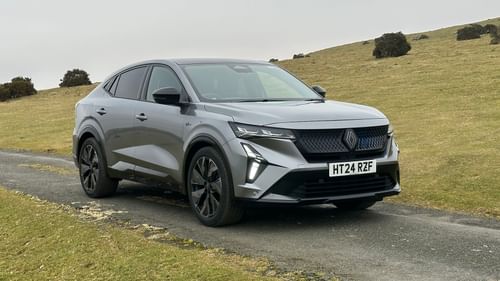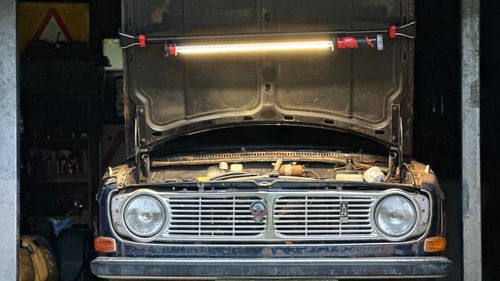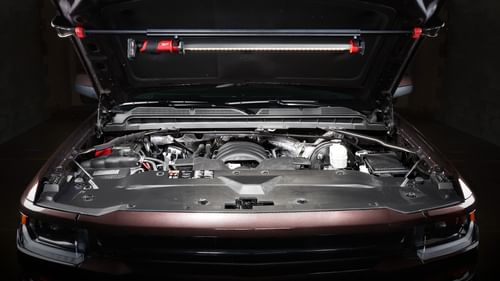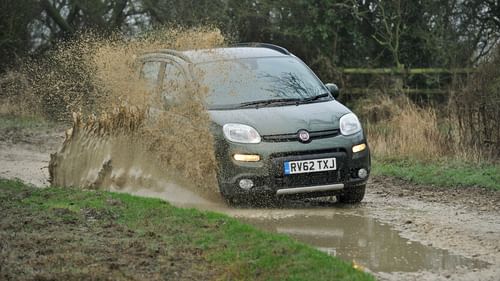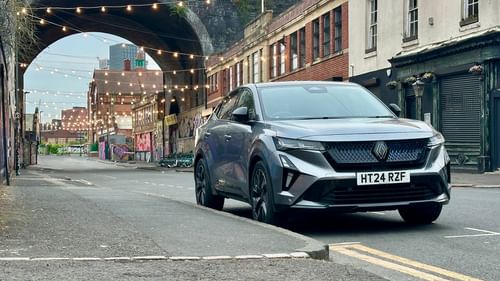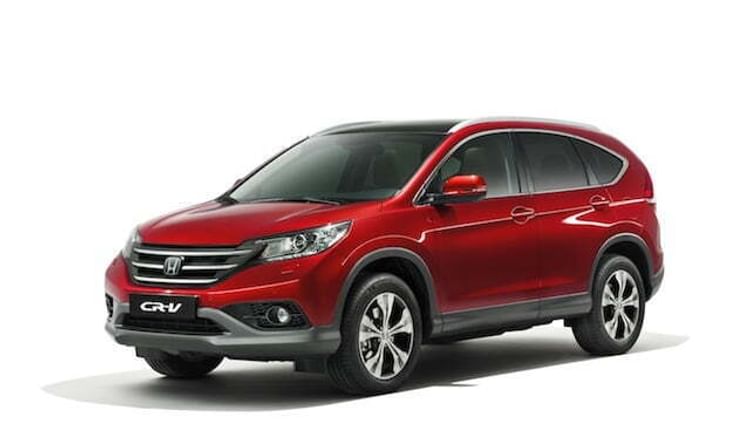
Robin Brown clearly can't get enough of the Honda CR-V. After flying out to Munich to review the new car last year, he subsequently travelled to Scotland to repeat the process. Still, it gave him the opportunity to test the new CR-V against the old model, along with other products wearing a Honda badge. Here are his words from Scotland.
Not long ago i was reviewing the Honda CR-V on the international launch in Munich, but due to industrial action I only managed to drive the 2.2-litre turbodiesel; the 2.0-litre petrol remaining undriven - by me at least - as we literally ran across the airport to get the last flight out of the country before the country closed down for the weekend.
I managed to drive the petrol model on a recent jaunt up to Scotland, where I sampled Honda power courtesy of the new Civic, the old CR-V, the current CR-V, a powerboat and an ATV (better known as a quadbike). Throw in a hot air balloon and ASIMO and I think that would have been about it.
The petrol CR-V - a car no-one will buy
First off the petrol CR-V; a flexible engine that pretty much no-one will buy. It turns the CR-V into a rather different beast, with quicker throttle response and altogether more power. I think I even got some air going over a particularly sharp crest on Scotland's rolling roads - and the brakes were able enough prevent another addition to the area's tarmac death tracks.
 So, who will buy this specific model? No-one, if they've got any sense. Despite managing to wring almost 40mpg combined out of some expressive B-road driving, the combination of tax, insurance and fuel economy should rule this out for virtually any buyer in this sector. The coming two-wheel drive 1.6-litre diesel, on the other hand, should make buyers sit up and take notice.
So, who will buy this specific model? No-one, if they've got any sense. Despite managing to wring almost 40mpg combined out of some expressive B-road driving, the combination of tax, insurance and fuel economy should rule this out for virtually any buyer in this sector. The coming two-wheel drive 1.6-litre diesel, on the other hand, should make buyers sit up and take notice.Honda has struggled to offer smaller engines in the CR-V range in the past, so this two-wheel drive model - retailing at almost ten grand less than the current entry-level model - will attract sales from the likes of the Nissan Qashqai.
Of course, the whole gist of my last review was that the CR-V had not moved on much from the last iteration; rather like a neanderthal heading down an evolutionary dead-end. There were improvements across the board, but while the recipe had changes, the mould was fundamentally the same. This isn't necessarily a bad thing - there's a lot to be said for knowing your market and providing what it wants - but Honda has acknowledged that its current line-up isn't winning many new customers.
Honda needs to reduce the average age of its customers
That's all set to change with the NSX on its way and a hot version of the new Civic slated for 2015. There may even be some warm versions of the hatch in the meantime too, as new CEO Takanobu Ito - a man who PetrolBlog is fond of, given that he's known to take superbikes onto the roads of Japan - tries to reinject some passion back into the marque's products.
 Honda has the engineering chops and is currently celebrating a touring cars win, so clearly they have the ability. And it wasn't so long ago that the S2000 - a car frequently referred to in revered and somewhat frightened tones - was on Honda forecourts. So I'm eager to see what Honda can do as it looks to reduce the average age of its core customers to double digits.
Honda has the engineering chops and is currently celebrating a touring cars win, so clearly they have the ability. And it wasn't so long ago that the S2000 - a car frequently referred to in revered and somewhat frightened tones - was on Honda forecourts. So I'm eager to see what Honda can do as it looks to reduce the average age of its core customers to double digits.So the future looks bright for those who look to Honda for some cars to fall in love with, even if the present seems to be business as usual with Honda. But what of the past? The CR-V event afforded me the chance to drive the outgoing CR-V, a few examples of which are probably on run-out across the country if you're looking for a bargain.
Old CR-V - the last word in uninspired car design
The overwhelming impression of the MKIII CR-V is of a car that could still sell in the UK without disgracing itself. The exterior looks rather more dull than the new car but that's both because the new crossover is actually pretty oddball, with a distended rear quarter, sleek looks all round and a beltline that looks higher than Simon Cowell's - and because the old one was the last word in uninspired car design.
The front end of the outgoing CR-V is particularly hard to look at for any amount of time and I'm finding it genuinely hard to find anything to say about it. Inside the story is rather the same: it's functional, drab and rather forgettable. The centre stack looks comfortably a decade old and the housing for the agricultural handbrake looks like it's come out of a van.
Fire up the engine, however, and there's a reassuring chunter from the dependable and able 2.2-litre turbodiesel. While that's a good thing, it's one of many reminders that the outgoing CR-V has a lot of similarities with the new one.
Thankfully that doesn't extend to the driving dynamics. The new CR-V is hardly rewriting the rule book in this area, but it's noticeably better to drive than the old model. Where body roll is more controlled in the new one, the MKIII CR-V wallows around corners like a whale on casters. It makes for a nauseating experience if you're driving around the backroads – and the steering feels imprecise and far too light.
The new CR-V is subtly but noticeably better
Jump into the new CR-V and the differences are subtle, but increasingly noticeable. While some of the switchgear is actually the same, the new knobs are much nicer to look at. Similarly the fit and finish is a step up – there's a reassuring heaviness and solidity to everything, perhaps most noticeably in the doors.
 There's an impression that the cabin is larger too. There's a modest increase in boot-size but the cabin seems more airy, and certainly more modern. Modern SUVs and MPVs have moved so far away from where they were 15 years ago they're frequently indistinguishable from cars when you're driving them.
There's an impression that the cabin is larger too. There's a modest increase in boot-size but the cabin seems more airy, and certainly more modern. Modern SUVs and MPVs have moved so far away from where they were 15 years ago they're frequently indistinguishable from cars when you're driving them.The MKIV CR-V feels rather more planted, secure and stable when you're pushing it, while never really giving the impression that there's a long way until you find the edge of the grip. Rather, one suspects that the car simply won't allow it. Meanwhile the 2.2 engine has been tweaked, bored and smoothed to the point where it gently chunters and tickover and you could be forgiven for mistaking it for a petrol while cruising. It's more efficient, quieter, cheaper.
The new crossover is a bit bigger. It's a lot more user-friendly. It's more comfortable. It looks nicer and is much more tactile and pleasing to the senses. The key stats don't really change a huge amount - but everything just feels... nicer.
Perhaps the biggest difference between these two iterations of the same car is how they make the driver feel - and this is something that's observable in the different generation of cars between the late 20th Century and the latter part of the Noughties.
The vast majority of cars are boring to drive
Modern cars are designed to do virtually everything they can to insulate you from the fact that you're driving a car. The vast majority of new cars are boring to drive; they are unengaging, quiet and safe. They offer palliatives to the horrors and dangers of modern car driving - the boredom, the frustration, the noise and dirt and sheer risk of piloting a two-tonne vessel at speeds of up to 150mph in close proximity to other such steel behemoths and so much tarmac, hard shoulder and wood.
Modern cars do their best to help us ignore these realities. Climate control to cool heated brows. Connectivity to take us away from motorways, slip roads and cones. Radio, CD and even DVDs to help us blank out the horror of it all outside in the jams. Seats that mould our backs and backsides one way and another to sooth aching bodies, stuck in these unnatural poses.
 But it's more than this. Like many new cars the MKIV CR-V tries to help us forget that we're driving a car at all - to make us think we're reclining in a comfortable chair; a beverage within a hand's reach and our little electronic toys close by. You don't ever really get any meaningful feedback from cars like this. It's hard to gauge what a car is doing because all of the electronic kinks are ironed out by computers, pumps and servos performing a thousand tiny adjustments every second. More and more sophisticated suspension set-ups take the ebb and flow out of a road, like a Steadicam correcting a cameraman's bouncing gait.
But it's more than this. Like many new cars the MKIV CR-V tries to help us forget that we're driving a car at all - to make us think we're reclining in a comfortable chair; a beverage within a hand's reach and our little electronic toys close by. You don't ever really get any meaningful feedback from cars like this. It's hard to gauge what a car is doing because all of the electronic kinks are ironed out by computers, pumps and servos performing a thousand tiny adjustments every second. More and more sophisticated suspension set-ups take the ebb and flow out of a road, like a Steadicam correcting a cameraman's bouncing gait.Noise, Vibration and Harshness engineering is - for the car geek - quite fascinating when you get into it. Men and women employed to listen to the noises that a car makes, like expert tea tasters with million-dollar tongues. Their job is to iron out squeaks, rattles, chugs, booms, whooshes, roars and pings. The noise of an engine, gearbox, tyre - or the wind whipping around a car. Pop up the bonnet on any new car and you'll see cladding inside the engine bay, designed to stop noise entering the cabin; to put physical and psychological layers between you and a whirring cacophony of metal, flammable fuel and hot oil.
New CR-V is superior but less satisfying
The new CR-V takes the existing template of the MKIII and refines, smoothes, tweaks and deadens. It is, in virtually every significant way, a superior car to the older model - and significantly so. And yet there's something more satisfying (on an admittedly antediluvian level) to me about the older car - perhaps the same reason I find a kart so much more enjoyable than a supercar; or my S-reg coupé more engaging than a new 2+2.
 The pleasure of driving means different things to different drivers. For virtually everyone who might buy a Honda in 2013 the pleasure they will find in a new CR-V will be in its ambiance, ergonomics, sense of sophistication and lack of fuss. They will appreciate the engineering that has gone into making a fairly dull car slightly more so - and that's good for them and for Honda.
The pleasure of driving means different things to different drivers. For virtually everyone who might buy a Honda in 2013 the pleasure they will find in a new CR-V will be in its ambiance, ergonomics, sense of sophistication and lack of fuss. They will appreciate the engineering that has gone into making a fairly dull car slightly more so - and that's good for them and for Honda.For the rest of us there's a certain reassurance about an old car that's a little more gruff, communicative and tactile. I hope that 2013 sees a recognition of this in Honda's new product - a little nod to the triumphs of the past when Honda didn't just stand for reassurance and dependability; it meant vitality, thrills and the simple, complex pleasure of driving.
MKIII CR-V as tested
- 2.2 i-DTEC EX Manual 4WD
- £31,105 (£30,605 basic)
- Performance: 150PS at 4000rpm; 350Nm at 2,000rpm
- Acceleration: 9.6 seconds
- Fuel economy: 43.5mpg
- CO2: 171g/km
- Length: 4,574mm
- Storage space: 556 / 955 litres
MKIV CR-V as tested
- 2.2 i-DTEC EX Manual 4WD
- Price: £31,495 (£30,995 basic)
- Performance: 150PS, 350Nm
- Acceleration: 0-62: 9.7 seconds
- Fuel economy: 48.7mpg
- CO2: 149g/km
- Length: 4,570mm
- Storage space: 589 / 1146 litres
Read more from Robin Brown here or follow him on twitter @robinbrown78.
Images © Robin Brown and Honda.
